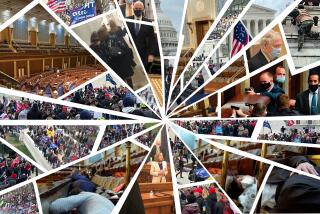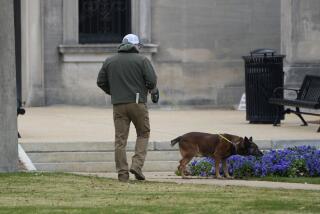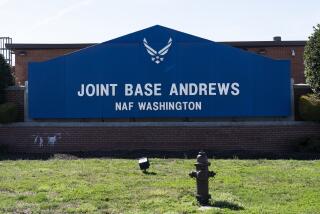Big Trouble for Small Plane in Washington
- Share via
WASHINGTON — Two men in a small private plane caused the frenzied evacuation of tens of thousands from the U.S. Capitol and the White House on Wednesday -- and narrowly escaped being shot down -- when they strayed deep into restricted airspace.
The airspace incursion to within three miles of the White House was described by military officials as the most serious since the Sept. 11 terrorist attacks. But it apparently was the result of simple inattentive piloting, officials said.
Still, the incident displayed the apparent success of elaborate new safeguards initiated since Sept. 11. Two F-16 fighter jets, joined by a Black Hawk helicopter and a Citation jet from the Department of Homeland Security, confronted the private plane in time to shoot it down, an order that was never given, defense officials said. “They were there in plenty of time,” said NORAD spokesman Master Sgt. John Tomassi.
The pilot failed at first to respond to urgent radio contact and to the first of four flares fired by the Air Force jets just off its wings, defense officials said. When the Cessna 152 was finally diverted, it was escorted to an airport in Frederick, Md., where the pilot and his passenger were questioned and later released.
The incident set off momentary panic among some government workers and a chain of events that shuttered Congress, the Supreme Court and a number of other Washington federal landmarks.
Capitol Hill workers described the exodus of federal employees -- about 25,000 work in the Capitol complex alone -- as fairly organized and speedy. Yet when senators and reporters outside the Senate chamber failed to move fast enough, police officers barked, “Don’t walk -- run!”
A fighter jet screamed overhead, and police emergency vehicles screeched through the streets as the crowd ran. Mounted police galloped through the crowds.
President Bush was on a bike ride at a suburban Maryland nature reserve at the time, about half an hour away by car. But Vice President Dick Cheney was evacuated from the White House in a motorcade to an undisclosed location, and First Lady Laura Bush and former First Lady Nancy Reagan, who was visiting, were removed to a secure location.
Friends identified the two men aboard the aircraft as Hayden Shaeffer of Lititz, Pa., a veteran pilot who was at the controls, and Troy D. Martin, a student pilot from Akron, Pa. The Cessna is owned by 10 members of the Vintage Aero Club of Smoketown, Pa., said club member Jack Henderson.
The two men were flying to an air show in Lumberton, N.C., when they were forced down, he said. Shaeffer is a flight instructor and Martin is his student, he said.
Henderson, the club’s acting secretary, described the men as “salt of the earth.” Shaeffer is retired and Martin is self-employed. The men’s families did not return phone calls on Wednesday. Henderson was at a loss to say how they could have strayed into restricted airspace.
“He seems like an adequate pilot,” Henderson said. “He obviously either misread the map, or his radios weren’t working properly. I don’t know how they stumbled in there.”
The plane was searched and the wayward pilots were questioned by teams from the Maryland state police, the Secret Service, and the FBI and released without charges. Their errant flight path was deemed accidental, said Secret Service spokesman Jonathan Sherry.
A government official who spoke on condition of anonymity said FAA controllers saw the plane on their radar before it entered the outer ring of Washington’s restricted airspace, which extends 14 miles in all directions from the Washington monument. All aircraft flying through this area must identify themselves to ground controllers.
But the pilot did not respond to attempts by FAA controllers to establish radio contact. Controllers were finally able to establish radio communication with the pilot after they learned the plane’s tail number and issued a specific call. That was at 12:15 p.m. By that time, the plane was already leaving the air defense zone and the all-clear was sounded, about 16 minutes after the alert took effect.
“It was obviously pilot mistake, and they were having some radio issues,” said Barry Maddox, a spokesman for the Baltimore FBI field office. “They were cooperative. There was no indication of harm to the public.”
The incident was referred to the FAA for possible civil penalties for violating restricted airspace, which could cost the pilot his license, Secret Service and FBI officials said.
“My understanding is, they were not allowed to leave in the airplane,” Maddox said.
In the Capitol, senators had just finished a procedural vote on a highway spending bill and House members were debating an antigang bill when the Capitol Police issued an order to evacuate the building. When senators and reporters outside the Senate chamber did not move fast enough, police officers barked: “Get moving, people! Head toward Union Station! You must clear the building!”
Some said they found the experience more annoying than frightening.
“It’s tiring, it’s very tiring,” said Linda Tarr-Whelan, a Virginia management consultant who had been attending a meeting in a Senate office building when the order to evacuate came. “I live in the Washington area, so you do what you have to do to be safe, but I’ve had it. I’m moving to South Carolina next month.”
Hundreds of people stood on the lawn between the Senate office buildings and Union Station, waiting for the all-clear order under a clear blue sky. One Senate staffer, who would identify himself only as Mike, said he believed the evacuation was more orderly than past episodes.
“This time, there is more method to the madness,” Mike said. “People are a little less panicked.”
It was the biggest government evacuation since the 2001 attacks. Since then, the Capitol and several other buildings have been evacuated because of fears of anthrax contamination and bomb threats. The Capitol complex was also cleared on June 9, 2004, when a plane carrying the governor of Kentucky to former President Ronald Reagan’s funeral entered the no-fly zone.
Capitol Police Chief Terrance Gainer said it took five or six minutes to entirely evacuate the Capitol on Wednesday. Gainer said he believed the evacuation went more smoothly than the one in June had.
Since the terrorist attacks, all flights over and near Washington have been tightly restricted and closely monitored. The restrictions have been violated hundreds of times, typically by wayward private pilots who don’t realize they have drifted into a highly restricted zone. Most of the violations are resolved when ground controllers make radio contact with pilots and order them to change their course.
In Wednesday’s incident, controllers were unable to establish communication, prompting a full-scale alert and the military intercept.
Because of the repeated problems with small planes, the government is installing a laser warning signal for pilots in the Washington area. It is expected to go into operation toward the end of this month.
*
Times staff writers Edwin Chen, Mary Curtius, Richard B. Schmitt, Ricardo Alonzo-Zaldivar and T. Christian Miller also contributed.
*
(BEGIN TEXT OF INFOBOX)
Air scare
A small private plane breached restricted airspace around Washington on Wednesday, prompting the evacuation of government buildings, including the White House.
Sequence of events:
11:59 a.m.: Threat level rises to yellow when a Cessna 150 is detected 15 miles northwest of the White House
Noon: Two F-16 jet fighters are scrambled from Andrews Air Force Base in Maryland
12:01: Threat level goes to orange with the plane 10 miles away; evacuations begin
12:03: Threat level rises to red, highest level; plane is three miles away
12:11: After interception by F-16s, plane has turned west, away from White House; threat level drops back to yellow
12:14: All clear sounded; plane is escorted to Frederick, Md., by a jet and Black Hawk helicopter
*
Sources: Jane’s Aircrafts, Times reporting by Tom Reinken
More to Read
Sign up for Essential California
The most important California stories and recommendations in your inbox every morning.
You may occasionally receive promotional content from the Los Angeles Times.










